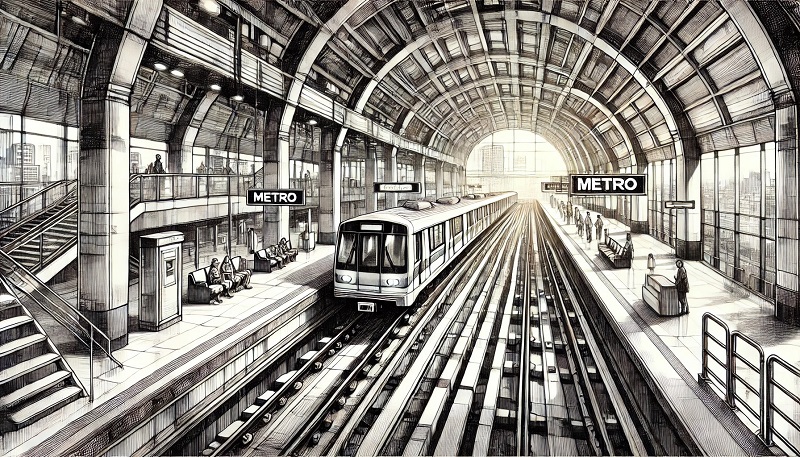Second metro line a great move for Hanoi's sustainbility
The people of Hanoi celebrate after a metro line that was 14 years in the making was finally inaugurated last week.
The Hanoi Times offers some thoughts on the Nhon - Hanoi Station metro line inaugurated last weekend.
Easing traffic strain
"Very fast," "very cool," "very modern," and "very convenient" were the main impressions of Hanoi residents and students who rode the Nhon - Hanoi Station metro line last weekend. This is the capital's second metro line, after the Cat Linh - Ha Dong line, which opened in late 2021.
Last weekend, my family and I decided to dive into the excitement of the new metro line. The kids were bubbling with anticipation, especially when they got their hands on round tokens shaped like the Khue Van Cac—the iconic Pavilion of the Constellation of Literature, which is a beloved symbol of Hanoi, instead of the usual paper tickets.
Our ride from Cau Giay Road to the bustling Xuan Thuy – Ho Tung Mau intersection was swift and smooth, so much so that the train’s motion was almost imperceptible.
The only downside was the large number of passengers being eager to try it out. While the kids snagged seats and delighted in the passing scenery, occasionally exclaiming as trains zoomed by in the opposite direction, the adults had to stand for the entire journey, packed amidst the lively crowd.
It seems likely that this will soon become a go-to mode of transportation for many, thanks to its convenience and seamless connections with other public transit systems. Most notably, it offers a much-needed escape from the maddening traffic jams that plague our congested streets.
Chu Thi Hai Yen and Nguyen Van Son, residents of Bac Tu Liem District, said they will use the metro every day because it is so convenient and will leave their private vehicles at home.
They won't have to deal with daily traffic jams and their travel time will be cut in half.
The line passes through 11 universities along the Cau Giay - Xuan Thuy - Ho Tung Mau route, including Hanoi University of Industry, University of Commerce, Hanoi National University of Education, Academy of Journalism and Communication, University of Transport and Communications, and six member schools of Vietnam National University - Hanoi.
The high volume of traffic in this area, compounded by the many office buildings nearby, has made it an epicenter of traffic congestion in recent years.
With the commissioning of the Nhon - Hanoi Station metro, the traffic nightmare for tens of thousands of students and office workers in the area will be over.
Many people have felt the annoyance of being caught in traffic, often only a short distance from their destination. I experienced firsthand the desperation of the traffic jam on Xuan Thuy Road in the Cau Giay district.
There was chaos on the roadway as cars, buses, and motorcycles piled on top of each other. The sidewalks were also used by motorcycles to escape.
In September 2010, work on the 12.5-kilometer Nhon – Hanoi Station metro line got underway. After 14 years, Hanoi's 8.5km Nhon-Cau Giay elevated line is now operational. This is the capital's second metro line, after the Cat Linh - Ha Dong line, which opened in late 2021.
During the first four trial days from August 8 to 11, the Nhon - Hanoi Station metro line carried approximately 256,000 passengers. On August 11 alone, some 100,000 passengers used the service, beating the previous record of 58,000 set by the Cat Linh - Ha Dong line on May 1, 2023.
These impressive figures show that the public has high expectations of public transport projects.
According to recent statistics, traffic congestion costs Hanoi about US$1.2 billion per year. Thus, metro projects like Nhon – Hanoi Station and Cat Linh – Ha Dong will help reduce economic and social losses and improve urban traffic conditions.
Prior to this metro line, the Cat Linh - Ha Dong line has relieved congestion along its route since its launch in late 2021, serving over two million passengers to date.
Boosting tourism and socio-economic development
Metro projects such as Cat Linh - Ha Dong and Nhon - Hanoi Rail Station connect suburban areas to downtown, reducing travel time and stimulating socio-economic growth in Hanoi's suburbs.
Simply put, tourists can easily find affordable lodging around Nhon and Yen Nghia stations, or along highways No. 6 and No. 32, all about 20 km from Hanoi's Old Quarter. With only VND14,000-15,000 (US$56-50 cents) per 15-minute metro ride, they can reach central districts such as Hoan Kiem and Ba Dinh.
By comparison, a bus ride from Nhon to downtown takes about 90 minutes, while a taxi is faster (45 minutes), but depends on traffic density and can be expensive.
In addition, the dense bus stops along the two metro lines make it easy for passengers to travel to other areas. About 36 bus lines are connected to the Nhon - Hanoi Station metro line.
Constraints, such as the requirement for a better-integrated support system with the urban metro, must also be addressed, though. More connected bus routes are needed to expand metro coverage and provide convenience for residents and tourists choosing the metro.
Hanoi also needs to strictly regulate and minimize any potential shortcomings in the metro lines to maintain rail safety and raise the standard of service on trains and at stations.
Hopefully, Hanoi will soon complete its urban rail network, laying the foundation for the city's sustainable growth.













